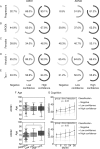A highly predictive signature of cognition and brain atrophy for progression to Alzheimer's dementia
- PMID: 31077314
- PMCID: PMC6511068
- DOI: 10.1093/gigascience/giz055
A highly predictive signature of cognition and brain atrophy for progression to Alzheimer's dementia
Abstract
Background: Clinical trials in Alzheimer's disease need to enroll patients whose cognition will decline over time, if left untreated, in order to demonstrate the efficacy of an intervention. Machine learning models used to screen for patients at risk of progression to dementia should therefore favor specificity (detecting only progressors) over sensitivity (detecting all progressors), especially when the prevalence of progressors is low. Here, we explore whether such high-risk patients can be identified using cognitive assessments and structural neuroimaging by training machine learning tools in a high-specificity regime.
Results: A multimodal signature of Alzheimer's dementia was first extracted from the ADNI1 dataset. We then validated the predictive value of this signature on ADNI1 patients with mild cognitive impairment (N = 235). The signature was optimized to predict progression to dementia over 3 years with low sensitivity (55.1%) but high specificity (95.6%), resulting in only moderate accuracy (69.3%) but high positive predictive value (80.4%, adjusted for a "typical" 33% prevalence rate of true progressors). These results were replicated in ADNI2 (N = 235), with 87.8% adjusted positive predictive value (96.7% specificity, 47.3% sensitivity, 85.1% accuracy).
Conclusions: We found that cognitive measures alone could identify high-risk individuals, with structural measurements providing a slight improvement. The signature had comparable receiver operating characteristics to standard machine learning tools, yet a marked improvement in positive predictive value was achieved over the literature by selecting a high-specificity operating point. The multimodal signature can be readily applied for the enrichment of clinical trials.
Keywords: Alzheimer's disease; cognition; machine learning; mild cognitive impairment; neuroimaging.
© The Author(s) 2019. Published by Oxford University Press.
Figures






Similar articles
-
Structural magnetic resonance imaging for the early diagnosis of dementia due to Alzheimer's disease in people with mild cognitive impairment.Cochrane Database Syst Rev. 2020 Mar 2;3(3):CD009628. doi: 10.1002/14651858.CD009628.pub2. Cochrane Database Syst Rev. 2020. PMID: 32119112 Free PMC article.
-
Machine Learning Predictive Models Can Improve Efficacy of Clinical Trials for Alzheimer's Disease.J Alzheimers Dis. 2020;74(1):55-63. doi: 10.3233/JAD-190822. J Alzheimers Dis. 2020. PMID: 31985462 Free PMC article.
-
Machine learning methods for predicting progression from mild cognitive impairment to Alzheimer's disease dementia: a systematic review.Alzheimers Res Ther. 2021 Sep 28;13(1):162. doi: 10.1186/s13195-021-00900-w. Alzheimers Res Ther. 2021. PMID: 34583745 Free PMC article.
-
Cerebrospinal fluid neurogranin: relation to cognition and neurodegeneration in Alzheimer's disease.Brain. 2015 Nov;138(Pt 11):3373-85. doi: 10.1093/brain/awv267. Epub 2015 Sep 15. Brain. 2015. PMID: 26373605 Free PMC article.
-
A robust brain signature region approach for episodic memory performance in older adults.Brain. 2021 May 7;144(4):1089-1102. doi: 10.1093/brain/awab007. Brain. 2021. PMID: 33895818 Free PMC article.
Cited by
-
A multiomics approach to heterogeneity in Alzheimer's disease: focused review and roadmap.Brain. 2020 May 1;143(5):1315-1331. doi: 10.1093/brain/awz384. Brain. 2020. PMID: 31891371 Free PMC article. Review.
-
The Canadian Open Neuroscience Platform-An open science framework for the neuroscience community.PLoS Comput Biol. 2023 Jul 27;19(7):e1011230. doi: 10.1371/journal.pcbi.1011230. eCollection 2023 Jul. PLoS Comput Biol. 2023. PMID: 37498959 Free PMC article.
-
The Road to Personalized Medicine in Alzheimer's Disease: The Use of Artificial Intelligence.Biomedicines. 2022 Jan 29;10(2):315. doi: 10.3390/biomedicines10020315. Biomedicines. 2022. PMID: 35203524 Free PMC article. Review.
-
A high-generalizability machine learning framework for predicting the progression of Alzheimer's disease using limited data.NPJ Digit Med. 2022 Apr 12;5(1):43. doi: 10.1038/s41746-022-00577-x. NPJ Digit Med. 2022. PMID: 35414651 Free PMC article.
-
Data-Driven Analyses of Longitudinal Hippocampal Imaging Trajectories: Discrimination and Biomarker Prediction of Change Classes.J Alzheimers Dis. 2022;88(1):97-115. doi: 10.3233/JAD-215289. J Alzheimers Dis. 2022. PMID: 35570482 Free PMC article.
References
-
- Mitchell AJ, Shiri-Feshki M. Rate of progression of mild cognitive impairment to dementia - meta-analysis of 41 robust inception cohort studies. Acta Psychiatr Scand. 2009;119:252–65. - PubMed
-
- Scheltens NME, Galindo-Garre F, Pijnenburg YAL, et al. .. The identification of cognitive subtypes in Alzheimer's disease dementia using latent class analysis. J Neurol Neurosurg Psychiatry. 2016;87:235–43. - PubMed
Publication types
MeSH terms
Grants and funding
LinkOut - more resources
Full Text Sources
Other Literature Sources
Medical

